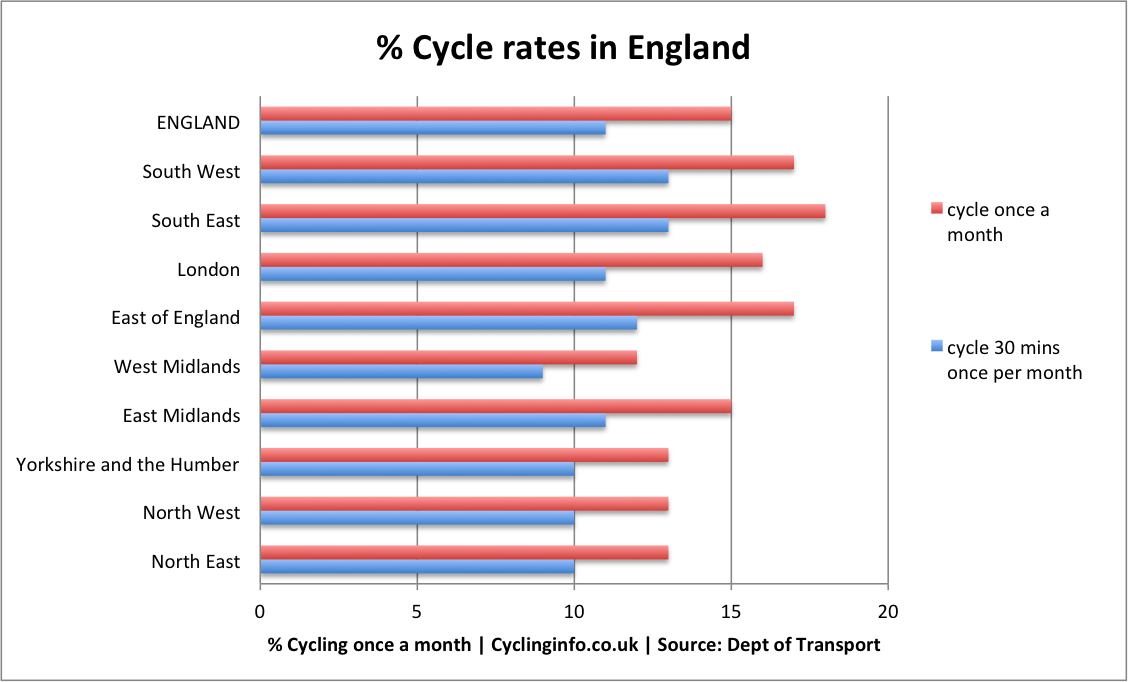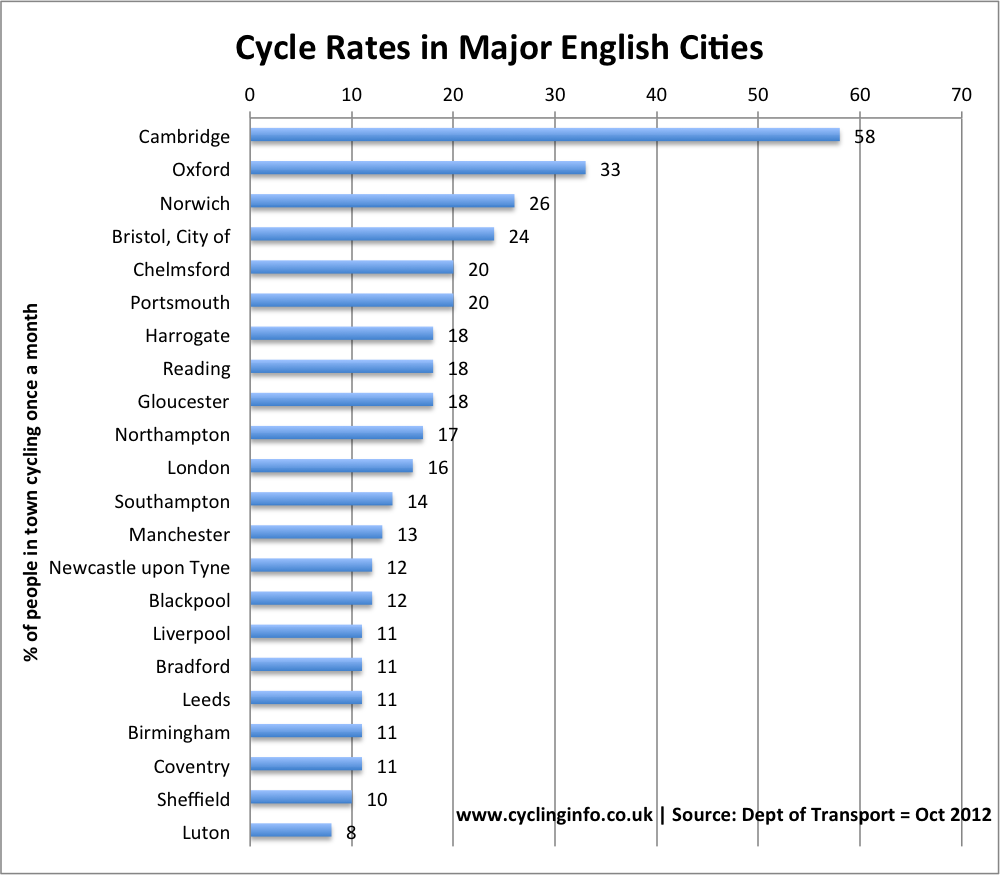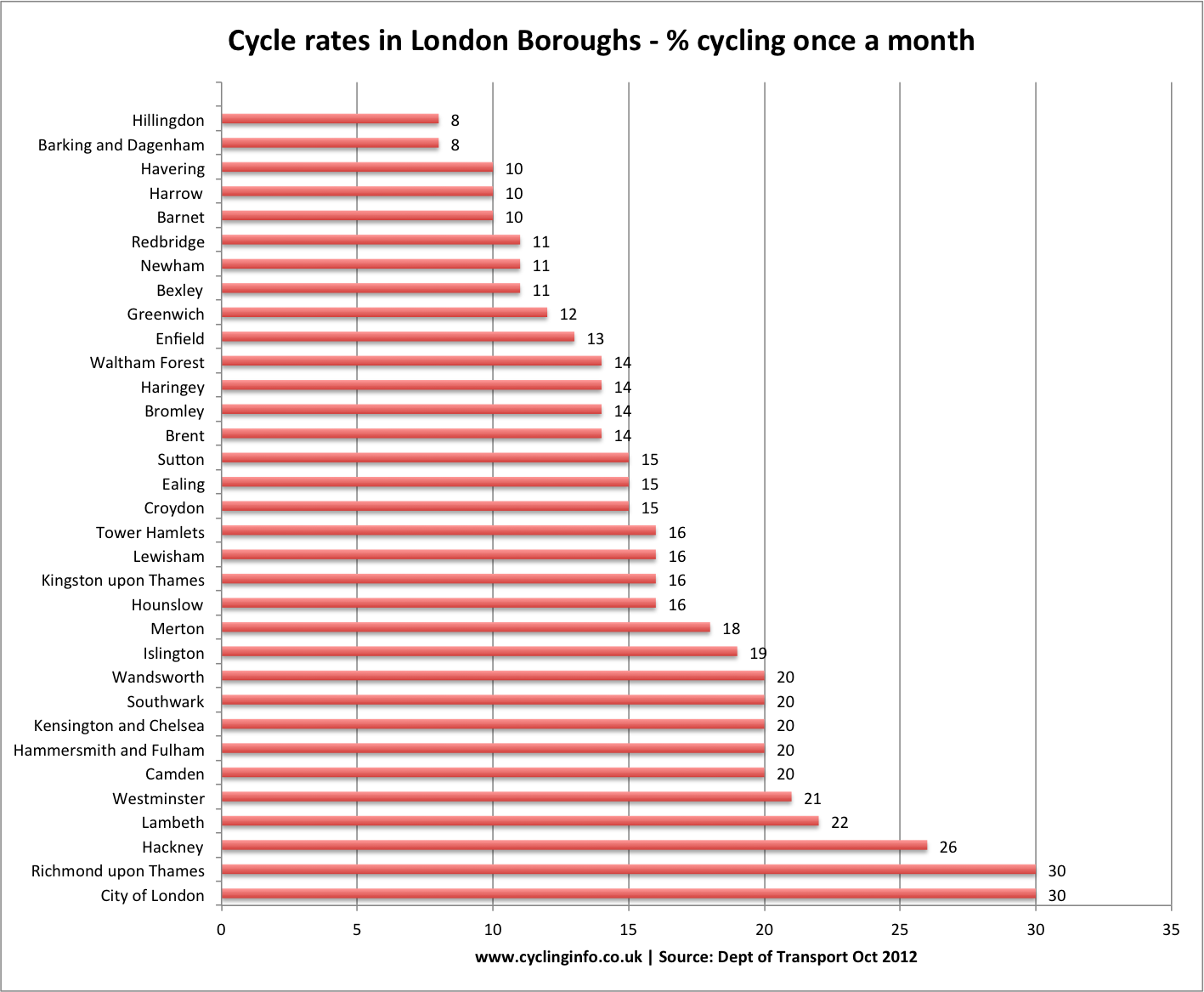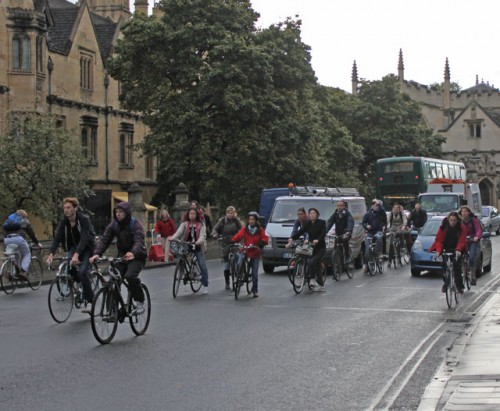Why do cycle rates vary so much across English cities? A look at why some cities may have high cycle rates, but in others a cyclist is a rare sight.
Cycle Rates by Region.

The difference between regions is relatively small. Cycling is highest in the South East – 18% cycle once a month. Compared to 12% in the West Midlands.
Cities have bigger variation in cycle rates

A lot of the traditional northern cities like Manchester, Liverpool, Bradford, Leeds and Birmingham have very similar cycle rates, stuck between the 11-13% rate.
Within Cities there can be a large disparity. This is most obvious is within London Boroughs.
Cycle Rates Within London Boroughs
% cycling at least once a month

cycle rates within London (click to expand)
Possible Reasons for Variation in Cycle Rates

- Tradition / History. People are more likely to cycle when they see other people cycling. If no-one cycles in a city, perhaps you subconsciously must think there must be a good reason. People often follow habits and patterns. Therefore, there is a cumulative effect with cycle cities encouraging more to join in.
- Safety in Numbers. Related to the first reason is the strong evidence for the benefits of safety in numbers. When cyclists are more visible in a city, motorists are more likely to expect cyclists on the roads and drive accordingly. When cyclists are in the minority, motorists may check mirrors less frequently and be more likely to miss cyclists. Higher rates of cycling make it more safe, and so encourage more cyclists. If you are deciding to take up cycling, the existing popularity of cycling will be a big factor.
- Profile of Cities. It is no surprise that cities with the highest cycle rates are geographically small with limited room for road expansion. Cities such as Oxford, Cambridge and York couldn’t cope with motor cars as the only means of transport. The demand is much greater than space. This has encouraged unorthodox transport policies such as limiting car use in parts of the city centres, one way systems and expensive parking. These measures to deal with traffic growth have swung the balance in favour of cycling. For example, the Cambridge city centre has large areas where cars cannot go, so the bicycle becomes the most practical means. By contrast, large cities such as Birmingham, Leeds and Bradford, have sought to accommodate road traffic and have inner ring roads which both make driving more attractive and cycling less attractive.
- Cycle Lanes. Cycle lane provision tends to be quite patchy even in the best cities. For example, cycle lane provision in cities like Oxford and York is highly variable – from the good to useless. Some routes like the millennium bridge in York offer car free routes. But, the main arteries in Oxford and York are still shared with cars and buses.
- Cycling advocacy. Some of the cities with the highest cycle rates are ‘cycling towns’ – Places with strong local campaigns to encourage cycling.Bristol, Cambridge. Cycling advocacy and effective local campaigns may encourage people to cycle. But, there is also a chicken and egg effect, with the most popular places to cycling tending to have more people willing to start and promote cycle campaigns.
- Infrastructure. Cycle infrastructure is frequently cited as the most important factor in encouraging cycle use. If there is good cycle paths and junction designs, this encourages cycling. Campaigners point to the high cycle rates in European cities such as Amsterdam and Copenhagen and there good levels of infrastructure. This is definitely a factor, but it is definitely not the only one. For example, Plymouth was voted as the city most favourable for cycling in (Plymouth named most cycle friendly). But, it’s cycle rate was 15% – no better than the national average. Even cities with high cycle rates – Cambridge, Oxford – you will get plenty of people complaining about the lack of cycle facilities.
- Weather. I don’t think weather makes much difference. E.g. the weather doesn’t explain variance within London boroughs. It is possibly a factor in explaining why cycling is slightly more popular in southern regions than northern regions. (when it rains, I think there are less cyclists in Oxford)
- Geography. Sometimes it is argued that cities with flat topography encourage more cyclists. E.g. Cambridge with the highest cycle rates is almost flat. But some hilly cities, such as Bristol are still able to have better than national averages. Some London Boroughs with the lowest cycle rates are quiet flat. I don’t know how important this is.
Related
- Cycling England
- Cycling statistics
- Cycle Rates
- Cycling in Bradford – a visit to a city with a low cycle rate.

I’ve just started cycling after a gap of thirty years or so. Perhaps it’s not PC to say so, but surely there is a class/ethnicity aspect to cycling rates – not just based on income differences?
On a related issue, shouldn’t “responsible”, mature cyclists make a point of cycling with due caution on pavements by busy roads where there are very few pedestrians? In Japan, it is the norm to cycle alongside pedestrians.
Personally, I live in Sheffield, and I think it has a lot to do with the hills in this area. When i started getting back into cycling from a point of no fitness, getting out in the Peak District required a good deal of effort. Not bad once you’ve passed a certain fitness level, but I’m sure it would put people off, or cause them to give up after only a short time. Only my opinon though
I’m sure hills put a few people off, though with the right gears most people should find a city like Sheffield OK.
Sorry, one more point of pedantry regarding the article about Plymouth. It wasn’t “voted” as you say. It was “named”. By researchers. There was no survey as reported elsewhere. The researchers arbitrarily allocated points as they saw fit, and Manchester beat Cambridge (!). Basically it was an advertising exercise for Virgin Money. More criticism here. http://www.bikebiz.com/news/read/the-uk-s-most-cycle-friendly-town-is-plymouth/013113
Yes. Maybe I should get Virgin to ‘name’ by blog as best cycling blog
More on geography, I live in Manchester where it is also relatively flat and we have the two largest universities in the country.
I posted a link on the University Cycling Club’s facebook page a while ago asking why they thought so few people cycled, compared to Oxford and Cambridge for example? Within a few minutes I got a response that riding down Oxford Road means “taking your life in your hands”. I thought this response was especially telling from a group consisting of gung-ho sports cyclists.
The Oxford Road corridor is the main route between student halls and the university. It’s a couple of miles on flattish terrain between them. But it’s also apparently the busiest bus route in Europe and most of the cycling is shared bus/cycle lane.
So I’m going with “perception of safety” as the main reason, which can be seriously improved with good infrastructure. I read your linked Independent article about Plymouth. The couple of comments are VERY critical, opining that Plymouth has little in the way of good cycling infrastructure. The researchers apparently also focussed on bike thefts and bike repair stores, which have nothing to do with infrastructure. Obviously more bikes get stolen in Oxford, there are a lot more bikes to steal and no-one locks them to anything!
Also, I’ve cycled in Oxford, and while you could argue there’s not too much infrastructure aimed at bikes, the traffic can be quite slow, there are lots of handy cut-throughs with little traffic and cycling along the river feels lovely and safe on a sunny day.
I notice that you say there is “strong evidence” for the safety in numbers theory, but all you link to is your own article, which contains no links itself, and makes the schoolboy scientific error of mistaking correlation for causality.
Is it really surprising that lots of people are cycling where it’s relatively safe to do so? Perhaps you have the cart before the horse?
I’m not the only one tempted to disagree with you, although I appreciate that intuitively it might seem to make sense that drivers are more likely to look out for cyclists where they’re used to seeing them.
I would recommend this blog post from a few days ago which actually looks at the “evidence”.
http://aseasyasridingabike.wordpress.com/2012/10/03/swimming-with-sharks-the-truth-about-safety-in-numbers/
Given the uncertainty about this I would suggest it shouldn’t be number two, and perhaps not on the list at all.
Thanks for comments Steve. Quite interesting. I guess I was thinking of something like
http://www.ctc.org.uk/desktopdefault.aspx?tabid=5225 for safety in numbers. But, like many things can be hard to prove.
It’s Tim. And unfortunately that seems to be another link to a page with no evidence and no links to any.
Just recently the CTC have been getting some grief for being in a bit of a muddle about what might make cycling more popular in the UK.
( http://departmentfortransport.wordpress.com/2012/09/14/is-the-ctc-helping-or-hindering-bike-use-in-the-uk/ )
They argue that they were the first to know about Dutch style infrastructure, and are in favour of it, but then they put segregated cycle paths at the bottom of their infamous “hierarchy of provision” and the relevant pages on their website have sections dedicated to “What’s wrong with off-carriageway provision?”.
Some of their campaigning seems to concentrate on the low-hanging-fruit – i.e. trying to change behaviour with mantras like “safety in numbers”, and “everyone play nicely”, despite the lack of evidence that much good will come of it.
I say all this as a paid up member. They are also helping raise the profile of utility cycling, campaigning for cycling to school, and campaigning for lower speeds (with Sustrans), which is all great to see. But I hope everyone can agree on what Dutch-style infrastructure actually means, and be clear about it!
I’m confused by this, Steve: you complain of schoolboy errors then say there are no links to evidence. Does the evidence in the link to the http://www.ctc.org.uk/resources/Campaigns/0905_SiN_full_rpt.pdf not count as evidence?
Seems reasonable. Or is it mistaking correlation for causality?
I’ll be honest and say I didn’t click every link on the page and hadn’t expected a “brochure” to be the place where statistical arguments could be found. You could see that as an oversight on my part. Thank you for pointing it out.
I quite like a lot of what that document says. In particular I like the recognition that we need to consider potential cyclists as well as existing cyclists (which often doesn’t happen). And the clear recognition that it is, to a large degree, fear which stops those people cycling. It recommends slowing traffic in some circumstances as a way to improve the environment for cycling, as the Dutch do – I already mentioned this seems like an area where the CTC and everyone else agree.
But, again, for some reason it stops short (again) of mentioning separating bikes from big lorries (and the rest) on busy roads – despite that being a key Dutch policy. Instead the CTC seem to want to change behaviour with training and marketing. Plus this vague idea of “eradicating the disproportionate risk presented by large vehicles,”(but no mention of how).
Sorry, digressing again. Back to the matter in hand. A few figures with incomplete references indicating that some places with more cyclists have fewer KSIs leave me unconvinced. Especially when two of the potential best examples are the Netherlands and Copenhagen, which have already been debunked as they’ve had (relatively) huge investment in safer infrastructure. There’s no consideration of the direction of the correlation, or of confounding variables. I’m not saying there’s nothing in it. It would be nice if it was true. I’ve plotted the data from the CTC’s appendix b and you can see the correlation. But if you’re going to campaign on something or base a policy on it you want to know you’re right, rather than go with intuition and hope. By the CTC’s own argument earlier in the document, people will commute more where it feels safer and less where it’s scary. And safer infrastructure has been shown to work where SiN hasn’t (at least to my satisfaction). http://en.wikipedia.org/wiki/Correlation_does_not_imply_causation
Thank-you for this; I see I didn’t really understand the correlation/causality argument, but do now and am better off for that. I have been guilty of it in the past.
The upshot of what you say, and of Tejvan’s article, is that we persuade the government to greatly improve cycling facilities to make it safer, ideally through separating cyclists from motorised traffic, a la Dutch. Our biggest lobby group, the CTC, doesn’t seem to be on side and has prioritised education etc. How do we change that and through them, the government? Of course there are many other cycling groups that will lobby with authority.
Is it a matter of writing to our MPs or do we need to see an increase in deaths before something is done? (I’m not offering to mow down a few cyclists in my car for the greater good of cyclist generally)
Nice article and some good reasons for the variation… would you expect there to be any correlation (positive or negative) between wealth and cycling activity?
Re: wealth. That’s quite interesting question. In some cases, cycling is an economic choice (i.e. can’t afford a car). Yet sometimes, cycling’s revival is taken up by quite wealthy people.
Like in China growing wealth has led to fall in bike use. But, in England / US, I think it is fairly well spread out across the income brackets.
I don’t think cycling is normally an economic choice. Most cyclists I find are usually middle class and could afford a car. It is purely a lifestyle choice I think, in much the same way some eat organic. I usually find people on lower incomes usually use motorised transport and public transport. This could explain a north, south divide (more cities in the south having higher cycling rates). Having said that I know people who live less than a mile away from my work in the south and there are still many of them who drive to work.
It may be a sweeping generalisation and with no evidence, just what I have observed.